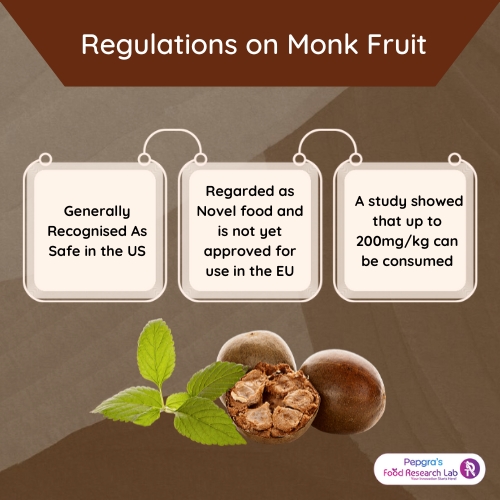
What are the safe regulatory levels for monk fruit?
Introduction
Food that tastes sweet is loved by millions worldwide, and sugar is the most common sweetening agent. However, sugar is associated with chronic diseases and conditions like type 2 diabetes, obesity and tooth decay. In addition, sugar is also said to lower immunity, and people who consume excess sugar have a higher risk of cancer. Therefore, national and international health organisations emphasise reducing dietary sugar to prevent chronic diseases and conditions. In addition, the food industry is aware of the increasing consumer awareness and dietary choices, preferring food with less added sugar or those that incorporate low-calorie sweeteners [1, 2].
Monk Fruit
Monk fruit is endemic to China and is also known as Luo Han Guo. The fruits were used as a folk medicine for treating a common cold, cough, sore throat and lung congestion. In the early 20th century, the fruit gained popularity as an ingredient in tea, cooling drinks and pork-based recipes for treating common ailments.
The ripe fruits contain mogrosides, oxo-mogroside and siamenoside, and mogroside V imparts sweetness to the fruit. The high-intensity sweetness of monk fruit renders its use as a sweetening agent and has been suggested as a sugar replacer in obese individuals and people with diabetes. It is said to be 300 times sweeter than sugar. Mogrosides remain undigested in the upper part of the digestive system, therefore contributing zero calories.
Monk fruit is rich in bioactive compounds like flavonoids, polyphenols, essential oils and triterpenoids. These substances have antioxidant, hypoglycaemic, antimicrobial, anti-cancer and anti-inflammatory activities.
Regulations on monk fruit ()

In the US, monk fruit was considered Generally Recognised As Safe (GRAS) in 2014. There was a subsequent spike in demand for monk fruit as a potent low-calorie sweetener in food and beverage industries, second only to stevia. The FDA states that people with diabetes, children, and pregnant women can all safely consume monk fruit sweeteners [3], but the FDA has not established the maximum daily intake of monk fruit [4].
In an article published in the European Food Safety Authority (EFSA) journal in 2019, mogroside 25% and 55% were studied on microorganisms and rats for their toxic potential. However, the results of safety and toxicity were inconclusive for using monk fruit as a food additive [5]. Therefore, it is not yet approved for use as a food additive per the EU regulations.
In a study by Xu Q et al. on humans, consuming a single dose of 200 mg/kg body weight of monk fruit did not affect the blood glucose levels, nor did it alter the liver enzyme profile and no adverse events were reported. However, it should be noted that the study was completed quickly, and the sample size was insufficient to make any inferences regarding the safety of monk fruit extract. In addition, there was no information regarding the composition of monk fruit extract [6].
Conclusion
Monk fruit is rich in bioactive compounds and is revered for its anti-inflammatory, antimicrobial and anti-cancer properties. It is gaining popularity as a potent low-calorie sugar substitute. Its use in the food and beverage industry is increasing. The USFDA categorised monk fruit as GRAS, but the recommended safe levels of monk fruit remain questionable. Therefore, it is recommended to follow the manufacturer’s instructions and consult a healthcare professional if the consumer has any concerns about the safe use of monk fruit extract.
How the Food Research Lab can help
The Food Research Lab offers B2B services in ingredient development. Our food technologist follow the recommended safety protocol, ensuring that the ingredient developed is of the highest quality and safe for consumption. In addition, we also conduct cost analysis during this process to help its clients economically formulate ingredients.





